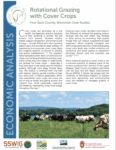The educational materials listed on this page are about Integrated Crop and Livestock Systems.
Crops and livestock were traditionally integrated in most farming systems. Integrated crop and livestock farming can improve nutrient cycling. Integrated management, or integrated farming, can also reduce off-farm impacts and improve water management. Integrated crop livestock systems also interrupt pest cycles on farms. Reduced economic risk through diversification on integrated crop-livestock systems is an added benefit to the integrated production system. Resources on integrated farm systems can be recycled more efficiently. Integrated crop and livestock operations may also benefit from increased efficiency in yields. The advantages to integrated agriculture are numerous for both the land and the farmer. Key practices include crop rotation, nutrient management, nutrient cycling, forage management, multispecies grazing, pasture fertility, physical control, stocking rate.
SARE’s Crop Rotation on Organic Farms: A Planning Manual can help farmers identify strategies that will help improve soil quality and health, and manage pests, diseases and weeds. A Whole-Farm Approach to Managing Pests is a helpful bulletin that serves as a guide in designing a farm-wide approach to controlling pests. Visiting The Small Ruminant Toolbox will aid producers looking to diversify their operation by incorporating small livestock enterprises, which provide added benefits to crop rotation and pest and weed control.
Showing 1-2 of 2 results

Rotational Grazing with Cover Crops Case Studies
Since rotational grazing of cover crops is not a common practice, to address some of the current questions from farmers in the upper Midwest, the Sand County Foundation of Wisconsin partnered with the Sauk Soil and Water Improvement Group and the University of Wisconsin-Madison to explore short-term agronomic and environmental costs and benefits of managed […]

Aquaculture and Aquaponics
Aquaculture is the cultivation of fish, aquatic animals, and plants. Aquaponics is a bio-integrated system that links recirculating aquaculture with hydroponic vegetable, flower, and/or herb production. In aquaponics, nutrient-rich effluent from fish tanks is used to fertigate hydroponic production beds. SARE has supported advances by producers, researchers, and educators that are helping to advance aquaculture and aquaponics into working models of sustainable production.